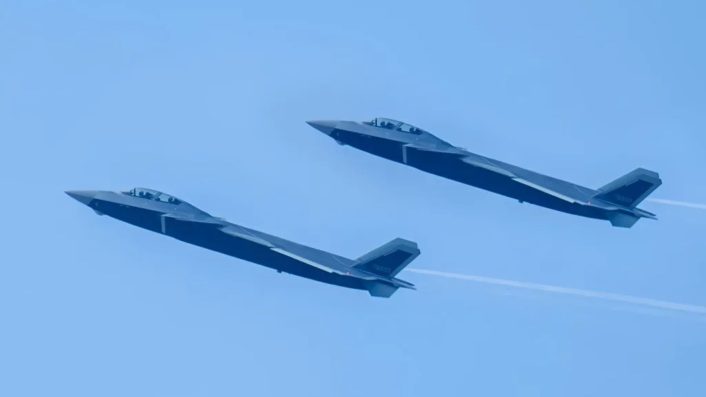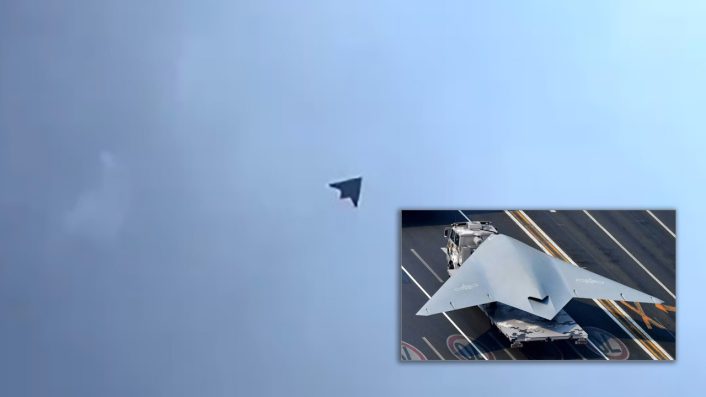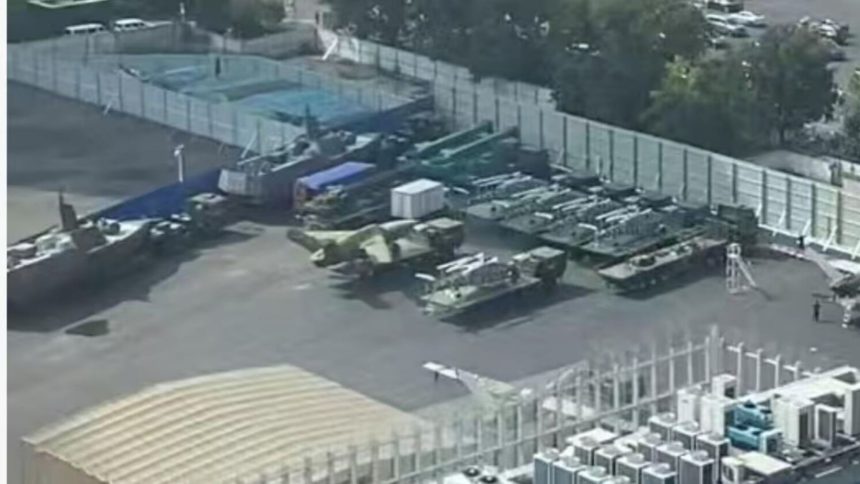The new UCAV will almost certainly translate into an acquisition for the PLA, given China’s tradition to display new military systems in its parades.
We may have the first unofficial image of one of China’s CCAs (Collaborative Combat Aircraft) on the back of a truck being prepared for the upcoming Sep. 3, 2025,, Victory Day parade. The grainy footage shows the UCAV together with a rotary wing unmanned aircraft and a Wing Loong-type drone .
Cursory observations link this UCAV to the FH-97 and FH-97A that have appeared in scale models since 2022 at exhibitions, shown dropping munitions from internal bays. Thus, this is a strong suggestion that the CCA may have been in some form derived from the FH-97 and, whatever the origins, is slated to fly alongside the J-20 stealth fighter.
As we will explain subsequently, it is a different matter that some analysts have called into question the existence of the FH-97 itself. The design also appears to resemble General Atomics’ YFQ-42A which, along with Anduril’s YFQ-44A, is slated to be among the U.S. Air Force’s first CCAs meant to fight alongside manned fighters.
As it seems, we finally have a slightly closer look onto one of the CCA/UCAVs on a truck being prepared for the September parade.
(Via REautomaton/SDF) pic.twitter.com/Ab0itdz5Gi
— @Rupprecht_A (@RupprechtDeino) August 16, 2025
New CCA
Compared to the FH-97, the new unnamed CCA is slightly different, with a thicker and shorter nose cone. The new aircraft appears to have a large internal volume, given how it is ‘fatter’ – for the lack of a better term – than the FH-97 or the YFQ-42A. However, it also might be the case that the angle and the lighting may be obscuring any prominent chine line it may have.
And another intersting find by bsdnf/SDF:
„Intermeshing-rotor UAV like Kaman K-MAX/CQ-24A? Very compact & foldable rotor design, which means it can be carried on ship. The large fuselage may be used for transport missions like the K-MAX, but closer to Z-20 and more reasonable.“ https://t.co/RUKU2ECRtk pic.twitter.com/tBoWY4vv0B
— @Rupprecht_A (@RupprechtDeino) August 16, 2025
The new CCA and the FH-97, however, share the broad design configuration. This includes a top-mounted engine, and a cranked-kite-type wing, somewhat like GA-ASI’s MQ-20 Avenger UCAV. The canted vertical stabilizers are another similarity. The type of exhaust configuration cannot be discernible in the pixellated image.
FH-97 Stealth UAV/loyal wingman along with FH-901 loitering munitions, meant to be launched from its internal weapons bay
It also features an electro-optical sensor pic.twitter.com/n3ma2OVSBy
— Húrin (@Hurin92) June 4, 2023
FH-97 and FH-97A
The FH-97A, which last appeared online in November 2024 in another full-sized scale model, had side-mounted intakes and a chin-mounted EOTS (Electro-Optical Tracking System), like the J-20. This was different from other FH-97A scale models seen in the November 2022 edition of the Zhuhai Air Show, which had the EOTS mounted on top, along with different munitions.
FH-97忠诚僚机的舰载版本FH-97A无人机已在中国珠海航展亮相。它将与076和福建航空母舰上的 J-35 战斗机一起并肩作战。 pic.twitter.com/FASordpw3a
— Eason Mao☢ (@KELMAND1) November 12, 2024
Andreas Rupprecht, a leading Chinese military aviation researcher, therefore even questioned whether the original FH-97 was “ever built and flown,” concluding it might have been “just a fancy airshow model.” The actual parade and clearer photographs, if they emerge in the run up to the day of the show, will show how much the new CCA shares with the FH-97 – or whatever unmanned CCA the notional designation envisioned.
Well, just to be sure concerning the FH-97A … was the original FH-97 ever built and flown? IMO not and I think it was so far just a fancy airshow model.
Or am I wrong? 🤔
(Image via @太湖啥个 from Weibo) pic.twitter.com/zZIKPIENGx
— @Rupprecht_A (@RupprechtDeino) November 2, 2022
We are still assuming these are two separate aircraft, until more light is shed. Nevertheless, that project has served as some form of inspiration for the CCA we see here, which, since it is going to be displayed in a parade, is sure to translate into a flying example – if it hasn’t already.
Rick Joe, another leading Chinese military analyst, shared an image of several new unmanned systems on the top of display trucks, which could be part of a dedicated “UAV contingent” in the Victory Day parade. Joe added that the PLA has been working “quietly behind the scenes” on CCAs and UCAVs specializing in air-to-air combat, and the FH-97 and its FH-97A variant “are just a tiny sliver of industry effort” in that direction.
GE from June shows a UAV contingent may be part of the Victory Day parade in Sept (like 2019 parade).
We see GJ-11 pattern (boxed red), and a ?MALE airframe (black).
Multiple new airframes that may be CCA in nature (blue) also seen.
Display trucks are 12.5m long, for scale. pic.twitter.com/5oucbzRwpf
— Rick Joe (@RickJoe_PLA) July 17, 2025
J-20
The J-20 has rapidly progressed and now the newer J-20A transitioned to the homegrown fifth generation WS-15 supercruise-capable engine, replacing the Russian Saturn AL-31 and the Chinese WS-10 turbofans. The twin-seat J-20S broke cover in August 2022 and possibly also entered active service, given images that circulated in early July. In fact, the paint schemes, markings and tail numbers suggest transition from prototype testing phase, and possible assignment to an operational unit.

Being the first fifth-generation stealth fighter to have a dual-seat variant, the J-20S is more suited for controlling collaborative UCAVs, besides the more advanced electronic warfare, target acquisition and networking functions. Interestingly, another aircraft depicted on CCTV as the J-20’s loyal wingman is the GJ-11 Sharp Sword.
So far one of the best Images of a PLAAF J-20S pic.twitter.com/q0ahylT5Os
— @Rupprecht_A (@RupprechtDeino) July 8, 2025
That pairing however now appears dim, given that the GJ-11’s mock-ups have been seen in satellite images of a full-sized carrier test facility in late December last year and a training site on Changxing island in Shanghai in June 2024.
Via ACuriousPLAFan/SDF: 😮
Supposedly not a recent image, but still the carrier mock-up and test facility at Wuhan has gained some new aircraft: Visible now are clearly mock-ups of J-15, J-35, KJ-600 and a GJ-11H on the flight deck.
(Image via @伏尔戈星图 from Weibo) pic.twitter.com/UL6uk81zh4
— @Rupprecht_A (@RupprechtDeino) December 19, 2023
Given that the mock-up was just a mile away from where China’s new Type 076 LHD (Landing Helicopter Dock) is being built, and Chinese military observers noted that the test facility’s dimensions are closer to the Type 076’s flight deck, the GJ-11 could possibly be meant to operate from there. Prior to that, the GJ-11 was unveiled at the Singapore Air Show in February 2024.

Conclusion
We have also seen other Chinese UCAVs, like the massive CH-7 shown during its taxi trials six months after appearing in exhibition stalls and reports on Global Times that said it had completed testing, development phase, and is poised to enter operational service. Whether it will appear during the September parade remains to be seen.
The GJ-11, which first appeared in the October 2019 parade, also made it as a flying example. This is an indication that the CCA on the truck is certainly slated to be acquired and future unofficial videos might capture it flying overhead.
🇨🇳FH-97A UCAV model with different munitions: FT-8B, FT-8C, FT-8D, FT-9 or FH-901 loitering munition in Zhuhai Airshow 2022
(via wb/艺伟影像) pic.twitter.com/JYTt8obYfg
— Jesus Roman (@jesusfroman) November 3, 2022
China has already flown a third next-generation jet, after the J-36 and the J-XDS. Even if we conclude this being a PR stunt with a propaganda goal, with the rapid introduction of new generation manned and unmanned systems, there are too many ‘flying examples’ to be written off as mere political statements.









